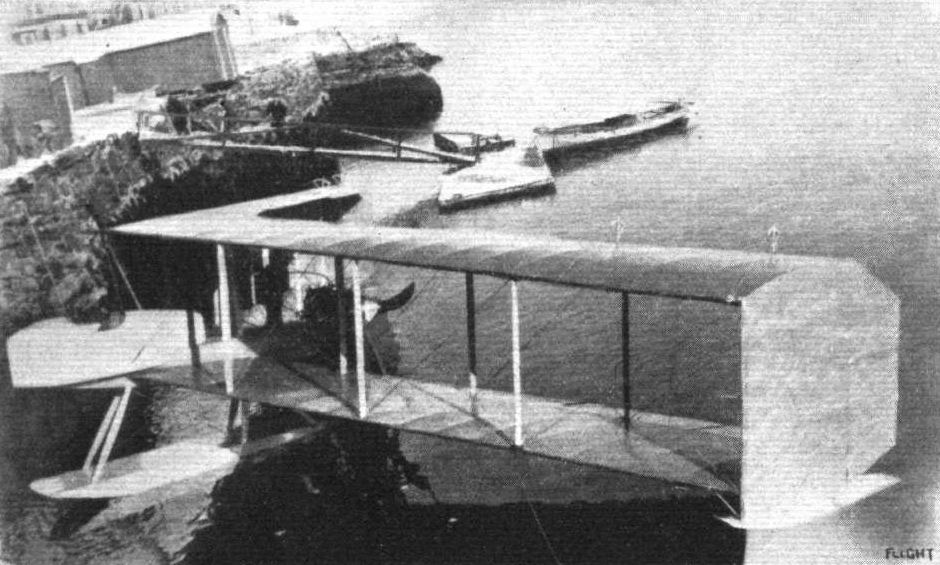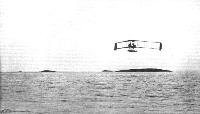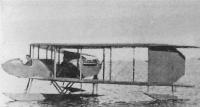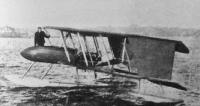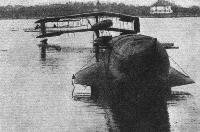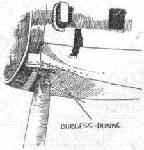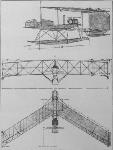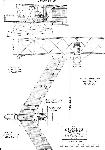G.Swanborough, P.Bowers United States Military Aircraft Since 1909 (Putnam)
BURGESS-DUNNE TAILLESS
The Dunne Tailless biplane developed in England was manufactured in the U.S. by the Burgess Company of Marblehead, Massachusetts. A single landplane example (serial 36) was evaluated by the Army at North Island, San Diego. Powered by a 200-h.p. water-cooled Canton-Unne radial engine the Burgess-Dunne achieved longitudinal stability by extreme sweepback of the wings, which put the elevators an effective distance aft of the centre of gravity. The control system used two levers; moved together, they raised or lowered the elevators, moved differentially, they turned the machine right or left through aileron action. Span 46 ft. 6 in.; length, 23 ft.
Показать полностью
G.Swanborough, P.Bowers United States Navy Aircraft Since 1911 (Putnam)
BURGESS-DUNNE AH-7, 10
Manufacturing rights to the British Dunne tailless aircraft were licensed to the Burgess Company of Marblehead, Mass, which built two seaplane versions (AH-7, AH-10) in 1916. Longitudinal stability was achieved by extreme sweepback (30 degrees). The Navy's first experiments in aerial gunnery were conducted with these pushers. Power plant, 100 hp Curtiss OXX-2. Span, 46 ft 6 in; max speed 69 mph.
Показать полностью
P.Lewis British Aircraft 1809-1914 (Putnam)
The American Burgess Company built three Burgess-Dunne single-float seaplane variants. These were the two-seat BD with a 100 h.p. Curtiss OXX2 engine, a span of 46 ft. and a top speed of 69 m.p.h., the BDH two-seater powered by a 140 h.p. engine, with a span of 46.6 ft. and a maximum speed of 70 m.p.h., and the BDI, which was a single-seater.
Показать полностью
Jane's All The World Aircraft 1919
Type B.D. is a Burgess Dunne sportsman's seaplane.
Type B.D.H. is a Burgess Dunne reconnaissance biplane with central floats.
Model Burgess Dunne. Burgess Dunne.
Type B.D. B.D.H.
Length 23' 31'
Span 46' 46'6''
Useful load, lbs. 670 350
Motor, h.p. 100 Curtiss Oxx2 140
Fuel capacity 4 hours 4 hours
Speed, Max 69 70
Speed, Min 45 40
Seating capacity 2 2
Показать полностью
Журнал Flight
Flight, June 19, 1914.
THE BURGESS-DUNNE HYDRO-BIPLANE.
DURING the last four months some very successful trials have been carried out in the United States with a Dunne hydro-biplane manufactured by the Burgess Company and Curtiss of Marblehead, Mass., U.S.A., who have acquired the sole rights to manufacture the Dunne machines in America. The production of a hydro-aeroplane on the Dunne principle presented numerous technical difficulties, in fact Lieut. J. W. Dunne himself considered that the inherent stability and the balance, both in the air and on the water, would be seriously affected by the fitting of afloat in place of the chassis, the former being considerably heavier and offering much more resistance than the latter. Mr. Burgess, however, set to work and went thoroughly into the matter of the Dunne principle, and after making exhaustive calculations as regards head resistance, weight, and centre of pressure under various conditions, he produced the first Dunne hydro-biplane, which balanced perfectly both on the water and in the air at the first time of asking. A comparison of the accompanying scale drawings of this machine with those of the land model published in FLIGHT for November 15th last, will show that except for the float, nacelle, and a few minor details, one does not differ from the other. In fact the principal dimensions and most of the constructional details are identical. It will, therefore, only be necessary for us to dwell briefly on the latter, so that we may confine our remarks to the modifications and actual performances. The swept-back planes are of the usual Dunne formation with the leading edge set at an inverted dihedral angle producing a negative angle of incidence at the tips, and are built up on two main spars of spruce, the front one forming the leading edge. The camber increases from practically nil at the centre to a maximum at the tips. It is to this peculiar formation that the Dunne machine owes its natural inherent stability, as has been described at length in the columns of FLIGHT.
At the centre of the lower plane is a short fuselage, rectangular in section and tapering fore and aft to a horizontal knife-edge. Mounted on the forward portion of this fuselage is a coracle-like nacelle, in which the pilot sits, whilst the rear portion carries the power plant. The latter consists of a 90-100 h.p. 8 cyl. Curtiss model O-X water-cooled engine driving direct an 8 ft. propeller. A single radiator is mounted immediately in front of the engine. The fuel and oil tanks, the former having a capacity of 22 gallons and the latter 4 gallons, are mounted on the upper longerons of the fuselage, two service tanks being placed within the latter just in front of the radiator.
The machine is supported on the water by a main central pontoon float 17 ft. 8 ins. in length and 3 ft. 1 in. beam, with a maximum depth of 15 ins. The float tapers to a horizontal knife-edge forward, and has a single hydroplane step at a point about one-third the length from the stern. It is divided into five transverse water-tight bulk-heads. Four pairs of spruce struts of steam-line section connect the float with the fuselage, the whole "chassis" being strongly cross-braced with wire. An auxiliary float is mounted at the bottom of each side curtain at the wing tips in order to support the latter when the machine rolls sideways. These auxiliary floats are similar in shape to the main float, but have no step. The Burgess Dunne is controlled in exactly the same manner as the land machine is. This control consists of ailerons only, operated by two separate levers, the right-hand lever operating those on the right side and vice versa. To ascend both levers are pulled back, causing the ailerons on each side to move up, and thus force the wing tips - which virtually form the tail of the machine, being located at the rear of the centre of gravity - down, a movement equivalent to that of the ordinary tail-elevator. To descend, the levers are pushed forward, with the reverse effect. When it is desired to direct the machine to starboard, the left-hand lever is pushed forward and the right-hand one pulled back, and the reverse for steering to port.
As regards the actual performances of this machine, Mr. Burgess made a few hops shortly after it was launched the latter part of February, but owing to exceptionally bad weather it was not until a few weeks later that the first successful flights were made at Salem Harbour, with Clifford L. Webster in the pilot's seat. Even then the weather was all but favourable, except as a severe test for the machine. However, the trials proved to be entirely successful, the machine rising easily from the water at a gentle angle. During one of his flights he locked the control levers and let the machine fly by itself. On May 2nd Webster put the second Burgess-Dunne through its tests before a number of members of the Aero Club of America. The second machine possesses several modifications calculated to increase its efficiency, otherwise it is similar to the other model. The radiator in front of the engine has been removed and a passenger's seat put in its place, whilst two radiators have been mounted on the rear float-struts. The demonstration with the second machine was made in a stiff N.W. wind with a choppy sea. After flying about two miles out to sea towards the observers with his hands off the controls, Webster made four circuits at 200 feet, taking his hands off the controls during the last circuit when the machine rose to a height of 500 feet. He then cut off the motor, and, with his hands still above his head, descended in a spiral to about 100 feet, when he resumed control and made another circular flight. Rising to a height of 500 feet, Webster once again took his hands off the controls, and glided in a straight line towards the observers. When 50 feet from the water, he resumed control, and, diving, alighted gently on the water and taxied to the observers' boat, to which the machine was moored for some time, withstanding the choppy sea exceptionally well. Another demonstration was made later on, in which Webster taxied some 200 yards away, and facing the observers he opened the throttle and raised his hands above his head. After hydroplaning for about 250 feet, the machine left the water and climbed gently to a height of 40 feet, when the pilot resumed control. Speed tests were also carried out, consisting of a run with and against the wind over a measured course of 1.2 miles. In one test the times taken were 59 secs, and 2 mins. 34 3/5 secs., whilst in another the times taken were 38 3/4 secs, and 2 mins. 38 4/5 secs. The average speed over a triangular course in a 10 m.p.h. wind was 5875 m.p.h. Numerous passenger flights were also made.
The principal dimensions of the Burgess-Dunne hydro-biplane are as follows :- Overall length, 24 ft. 8 ins.; span, 46 ft.; chord, 6 ft.; supporting area of main planes, 545 sq. ft.; weight of machine empty, 1,450 lbs.; useful load, 250 lbs.
Flight, September 24, 1915.
WATERPLANE SPORT IN AMERICA.
MR. ASTOR'S BURGESS-DUNNE SEAPLANE AND ITS FLOATING HANGAR.
SEAPLANING as a sport is rapidly increasing in vogue among our American cousins, thanks chiefly to wealthy enthusiasts such as, to mention a few, Verplank, McCormick, and Astor. While the two former have selected the Curtiss flying-boat type as best suited to their purpose, Mr. Vincent Astor, the American millionaire, has decided on a single float seaplane of the Burgess-Dunne type. Being a member of the New York Yacht Club it is only natural that Mr. Astor should during the past summer have had his machine stationed at Marblehead, where it has got through a great deal of air work over the bay. As built by the well-known Burgess firm of Marblehead, Mass., the Burgess-Dunne seaplane has proved very successful in every way both as regards weight-lifting and speed. Its stability is said to be perfect in all sorts of weather, and it appears to leave the surface easily and without any fuss when getting away. A single-stepped central float takes the greater portion of the weight, assisted, when the machine is at rest, by the two wing tip floats. As soon as the speed reaches a certain point, however, these wing tip floats leave the water, and the machine is then supported on the central float only. With a Curtiss OXX engine the Burgess-Dunne does over 65 m.p.h., and the total weight lifted is over 2,000 lbs.
In order to increase the usefulness of his machine, Mr. Astor has had a special floating hangar built for it by the Burgess Company. Should its owner so wish, the hangar and machine may be towed from Marblehead Bay to any other stretch of water, such as, for instance, the Hudson River, and used there for inland service. The floating hangar itself is highly interesting, as it is of a somewhat unusual design. It consists, as will be seen from the illustrations, of a large punt-shaped float on which rests the hangar itself, leaving a narrow promenade running round all four sides. From the stern of the hangar projects a well-supported steel beam, which carries on two small trolleys a differential hoist. The machine is brought up to the hangar after a flight, and the hoist cable is hooked into a ring just in front of the engine. Two men can now lift the machine out of the water, and when this has been accomplished the plane is swung round until it faces across the hangar, when a slight pull on the trolley suffices to bring it under cover, securely sheltered from rain and wind. There can be little doubt that the combination of the Burgess-Dunne seaplane and the floating hangar in which it is housed is admirably adapted for popularizing seaplaning, as it does not confine the activity of the machine to one particular locality, but enables moves to be made to suit the desires of the owner. If he so wishes, the summer months may be spent in the North, either on the Atlantic Coast or on one of the many inland lakes, whilst when winter makes climatic conditions uncomfortable for flying, the machine and its hangar may be sent down to the smiling Florida waters. What infinite possibilities for the future of the sport of aviation are here foreshadowed!
Показать полностью
